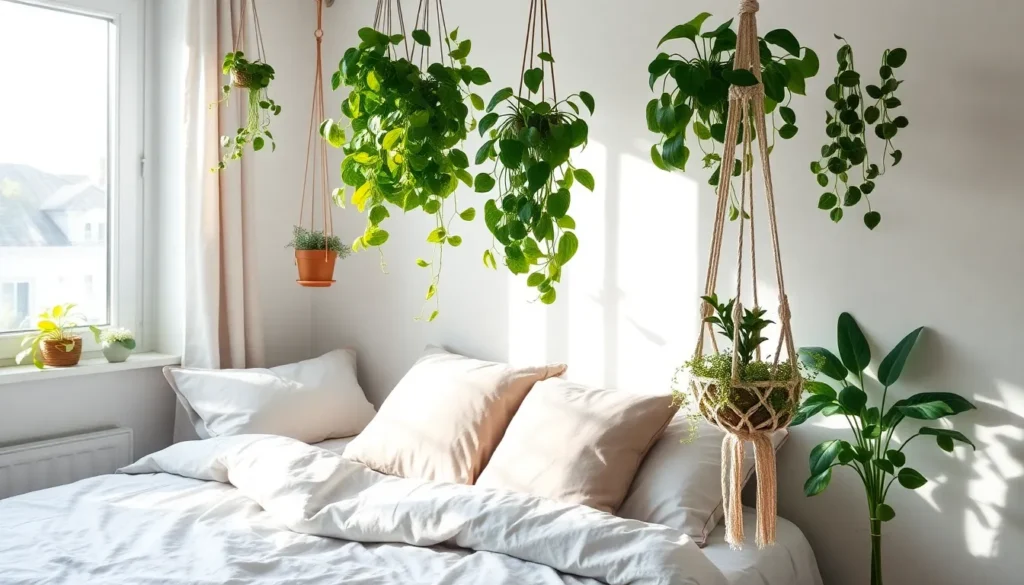We’ve all dreamed of transforming our bedrooms into peaceful green sanctuaries, and hanging plants offer the perfect solution for creating that botanical paradise. These vertical gardens don’t just save precious floor space – they literally elevate your room’s aesthetic while purifying the air you breathe every night.
Indoor hanging plants bring life to those awkward corners and empty wall spaces that traditional décor can’t quite fill. They create visual interest at eye level and above while making your ceiling feel higher and your room more spacious. From trailing pothos cascading like natural curtains to sculptural air plants suspended in geometric planters, there’s a hanging garden style for every bedroom design.
We’ll show you how to select the best low-light plants for bedroom environments, master the art of proper placement, and avoid common mistakes that kill hanging plants. Get ready to discover why bedroom hanging gardens are becoming the hottest trend in interior design.
Choose Low-Light Hanging Plants Perfect for Bedroom Environments
Selecting the right hanging plants for your bedroom requires understanding which varieties flourish in lower light conditions. Many bedrooms naturally receive less sunlight than other rooms in the house, making it essential to choose plants that won’t struggle in these environments.
Pothos – The Ultimate Beginner-Friendly Option
Pothos stands out as our top recommendation for bedroom hanging plants because it tolerates low light conditions exceptionally well. These trailing beauties can thrive in areas with minimal natural light, making them perfect for bedrooms with north-facing windows or limited sunlight exposure.
Golden pothos creates stunning cascading vines that can grow up to 10 feet long indoors, adding dramatic vertical interest to your bedroom space. We love how quickly these plants establish themselves, often showing new growth within just 2-3 weeks of proper care.
Marble queen pothos offers striking white and green variegated leaves that brighten darker bedroom corners naturally. This variety maintains its beautiful coloring even in low light, unlike many other variegated plants that lose their patterns in dim conditions.
Care requirements remain minimal for all pothos varieties, needing water only when the top inch of soil feels dry. These plants actually prefer to dry out slightly between waterings, making them ideal for busy lifestyles or frequent travelers.
Snake Plant Varieties That Thrive in Hanging Baskets
Snake plants adapt surprisingly well to hanging displays, even though their reputation as upright floor plants. Sansevieria trifasciata ‘Hahnii’ varieties work particularly well in hanging baskets because of their compact, rosette growth pattern.
Bird’s nest snake plants create stunning sculptural displays when suspended at eye level in bedrooms. These varieties typically reach only 6-8 inches in height, making them perfect for smaller hanging planters without overwhelming the space.
Watering needs for hanging snake plants decrease significantly compared to their potted counterparts, requiring water only every 3-4 weeks during growing season. We’ve found that overwatering poses the biggest threat to snake plants in hanging arrangements, so err on the side of underwatering.
Light requirements remain flexible for hanging snake plant varieties, thriving in everything from bright indirect light to low light bedroom conditions. These plants actually prefer stable, moderate lighting over dramatic changes in light exposure throughout the day.
ZZ Plant – Drought Tolerant and Air Purifying
ZZ plants excel in hanging arrangements because they naturally develop cascading stems when grown in elevated positions. Zamioculcas zamiifolia adapts to hanging baskets by producing longer, more flexible stems that create beautiful trailing displays over time.
Raven ZZ plants offer dramatic black foliage that creates stunning contrast against light colored bedroom walls. These darker varieties maintain their deep coloring even in low light conditions, providing year round visual impact in bedroom hanging displays.
Drought tolerance makes ZZ plants incredibly forgiving for bedroom environments where consistent watering schedules might be challenging. These plants can survive without water for 4-6 weeks, making them perfect for vacation periods or busy schedules.
Air purifying capabilities of ZZ plants actively improve bedroom air quality by removing common household toxins like xylene and toluene. NASA studies show that ZZ plants can remove up to 90% of certain airborne chemicals within 24 hours of exposure.
Select the Right Hanging Planters for Your Bedroom Decor
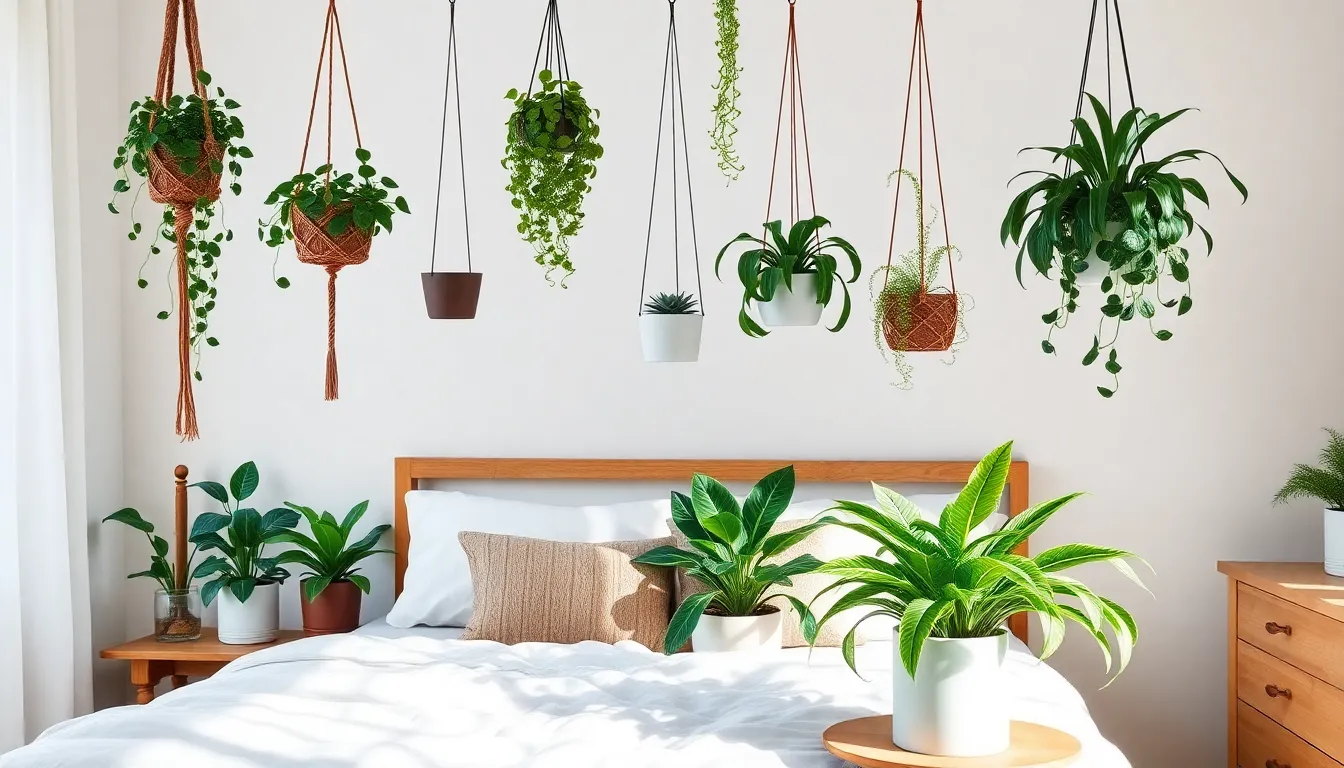
Choosing the perfect hanging planter transforms your bedroom’s vertical space while complementing your existing style. We’ve found that the right planter selection maximizes both aesthetic appeal and practical functionality in bedroom environments.
Macrame Plant Hangers for Bohemian Style
Macrame plant hangers instantly create a bohemian atmosphere that brings warmth to any bedroom space. These woven cord creations offer incredible flexibility in height adjustment, allowing us to customize the perfect positioning for our trailing plants. Natural rope materials add artisanal texture that pairs beautifully with wooden furniture and neutral bedding.
We love how macrame hangers complement woven baskets and create layered texture throughout the room. Their handcrafted appearance works especially well with plants like Pothos or trailing succulents, where the organic planter material enhances the natural beauty of cascading foliage. Rope construction means they’re lightweight enough for most ceiling installations while maintaining that relaxed, ethnic charm we’re seeking.
Ceramic and Pottery Options for Modern Aesthetics
Ceramic hanging planters deliver sleek sophistication that perfectly suits contemporary bedroom designs. We appreciate how their clean lines and smooth finishes create visual harmony with modern furniture and minimalist decor schemes. Various shapes and colors allow us to either blend seamlessly with existing palettes or create striking focal points.
Weight considerations become important with ceramic options, but their durability makes them worthwhile investments for showcase plants. Boston Ferns look particularly stunning in white ceramic planters, where the lush green fronds create beautiful contrast against the smooth pottery surface. Their substantial presence works best with sturdy ceiling mounts and shorter hanging distances.
Lightweight Plastic Planters for High Ceiling Installations
Plastic planters solve practical challenges in bedrooms with soaring ceilings or questionable mounting points. We recommend these for situations where weight reduction is crucial, as they significantly reduce strain on ceiling fixtures and installation hardware. Modern plastic options come in many styles that mimic ceramic or natural materials without the associated weight concerns.
These planters excel with cascading plants like Burro’s Tail or English Ivy, where higher positioning allows trailing growth to reach optimal visual impact. Their affordability also means we can experiment with different arrangements without major financial commitment, perfect for renters or those still developing their plant styling preferences.
Find the Perfect Spots to Hang Plants in Your Bedroom
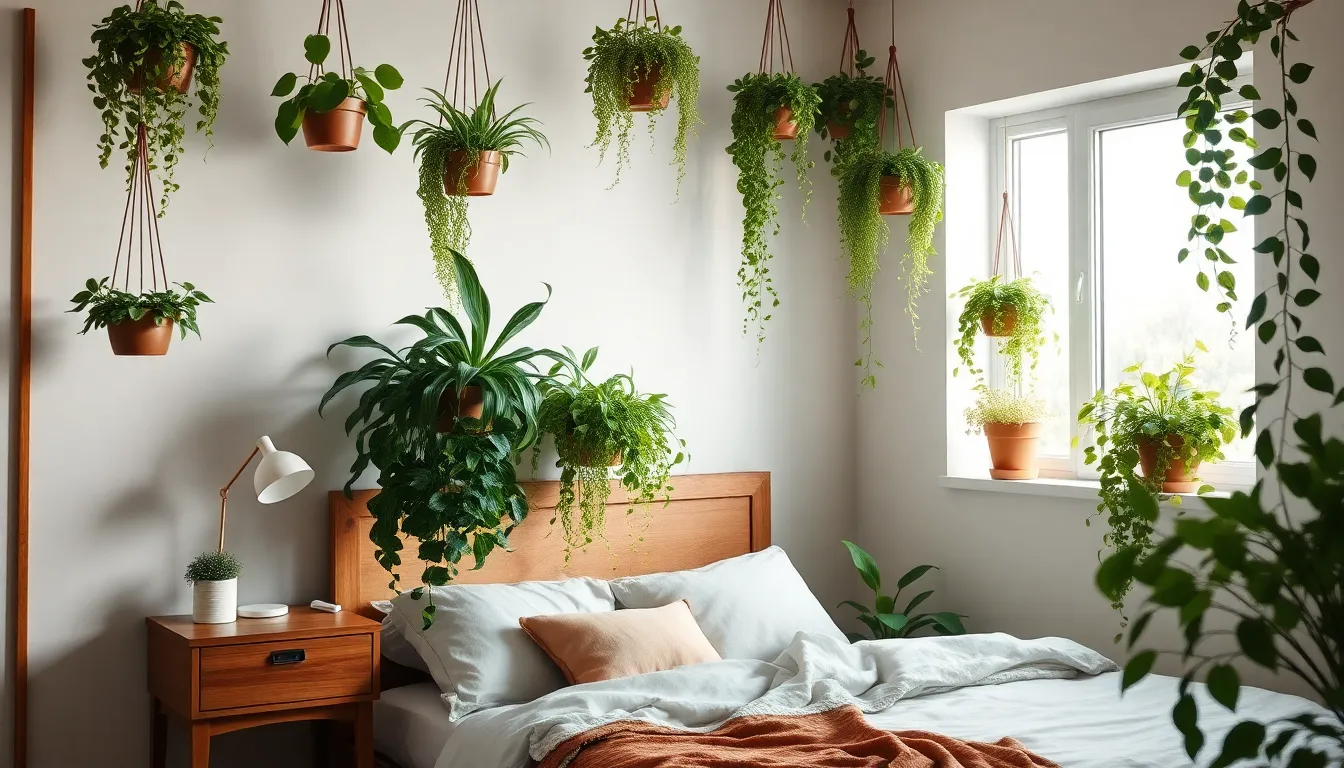
Once you’ve chosen your plants and planters, the next step is determining where to position them for maximum impact and plant health.
Near Windows for Optimal Natural Light
Windows provide the most natural light for your hanging plants, making them the prime real estate in your bedroom. We recommend starting with one plant near a window and monitoring its condition for a week before adding more to avoid overwhelming the space. Most plants thrive with natural light, but not all varieties prefer direct bright sunlight streaming through the glass.
Observing how light filters and changes throughout the day helps you determine the best placement for each plant. Plants that develop brown spots on their leaves are typically receiving too much direct sun and need to be moved to a spot with filtered light. Positioning plants near windows rather than directly in front of them prevents blocking natural sunlight from entering your bedroom while still providing adequate light for growth.
Corner Spaces to Maximize Floor Area
Corner spaces offer an excellent opportunity to add greenery without sacrificing valuable floor space in your bedroom. Empty corners near windows combine the benefits of natural light availability with efficient space utilization. These spots allow you to create vertical gardens that add dimension and visual interest without crowding furniture or creating obstacles in walkways.
Hanging plants in corners helps establish a calming, natural atmosphere while maintaining clear pathways throughout your bedroom. This placement strategy works particularly well for trailing plants that can cascade gracefully from elevated positions, creating a dramatic focal point in otherwise unused areas.
Above Nightstands for Easy Access and Care
Nightstand placement offers the perfect balance of accessibility and visual appeal for your hanging plants. Positioning plants above bedside tables makes watering and maintenance tasks much easier since you can reach them without ladders or stools. This location brings greenery close to your sleeping area, improving the room’s relaxing ambiance and creating a more intimate connection with nature.
We suggest avoiding hanging plants directly overhead to prevent any feelings of unease or discomfort while you rest. Instead, position them slightly to the side or above nightstands where they remain accessible and visually pleasing without intruding on your personal space. This strategic placement allows you to enjoy the benefits of bedroom plants while maintaining a sense of openness and comfort in your sleeping environment.
Install Proper Hanging Hardware for Plant Safety
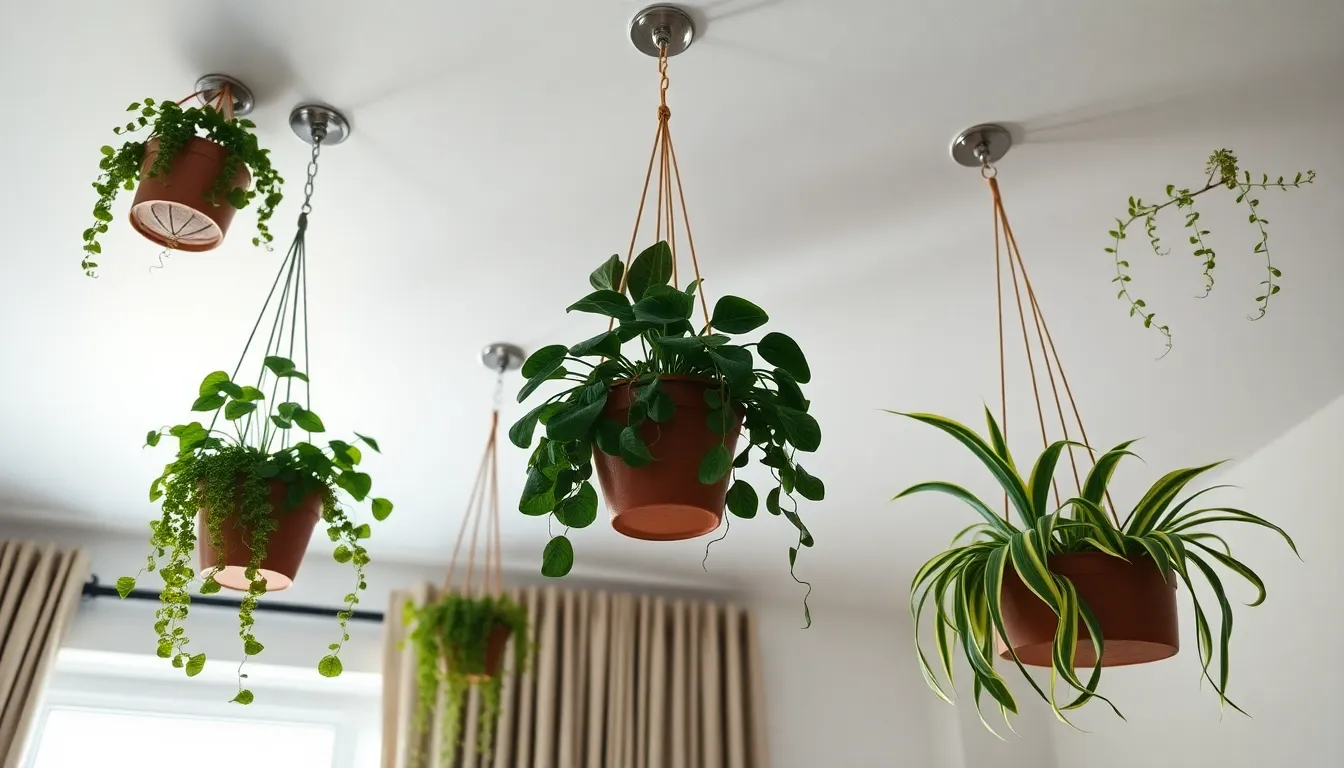
Choosing the right hardware becomes crucial when we’re ready to hang our carefully selected plants and stylish planters. We’ll need to consider both the installation method and the weight capacity to ensure our bedroom hanging garden stays secure and beautiful.
Ceiling Hooks and Anchor Requirements
Locating the perfect spot starts with marking our ceiling using a pencil where we want each plant to hang. We should measure the distance from walls and other fixtures to ensure proper spacing for plant growth and care access.
Drilling pilot holes prevents ceiling damage and ensures our hooks fit securely. We’ll need to drill a hole slightly smaller than our hook’s diameter before installation to create the perfect fit.
Toggle bolts combined with swag hooks provide the strongest support for drywall ceilings when ceiling joists aren’t accessible. These heavy-duty anchors can safely hold plants weighing 15-20 pounds and distribute weight across a larger ceiling area.
Ceiling joists offer maximum strength for our heaviest plants, supporting 30+ pounds when we locate them with a stud finder. We’ll drill pilot holes directly into the joists and insert our hooks for the most secure installation possible.
Proper installation technique requires inserting hooks or toggle bolts until they’re flush against the ceiling. We should test the stability by gently pulling on the hardware before hanging our plants.
Wall-Mounted Brackets for Side Hanging
Wall-mounted brackets serve as excellent alternatives when ceiling installation isn’t possible or when we want to create interesting side-hanging displays. These brackets allow our plants to hang sideways from walls, creating space-saving decorative arrangements.
Securing brackets into wall studs provides the strongest support for our hanging plants. We’ll use a stud finder to locate the wooden framework behind our drywall and drill pilot holes for our screws.
Heavy-duty wall anchors work well when studs aren’t available in our desired location. We’ll choose anchors rated for the exact weight of our plants plus their containers and soil.
Strategic placement of wall brackets lets us create cascading plant displays or fill empty wall spaces with living greenery. We can install multiple brackets at varying heights for ever-changing visual interest.
Weight Considerations for Different Plant Sizes
| Plant Weight Category | Recommended Hardware | Weight Capacity | Installation Method |
|---|---|---|---|
| Lightweight (under 10 lbs) | Simple hooks or tension rods | Up to 10 lbs | Basic wall anchors |
| Medium weight (10-20 lbs) | Toggle bolts with swag hooks | 15-20 lbs | Drywall anchors |
| Heavy plants (30+ lbs) | Ceiling joist hooks | 30+ lbs | Direct joist mounting |
| Multiple plant groupings | Tension rod with S-hooks | 10-30 lbs total | Wall-to-wall mounting |
Lightweight plants under 10 pounds give us the most flexibility in hanging options. We can use simpler hooks or even tension rods between walls, making them perfect for renters or temporary setups.
Medium weight plants requiring 10-20 pound capacity need toggle bolts with swag hooks or heavy-duty ceiling hooks in drywall installations. These plants include most mature pothos, snake plants, and ZZ plants in standard containers.
Heavy plants exceeding 30 pounds must be supported by hooks installed directly into ceiling joists for safety. Large ceramic planters with established plants often fall into this category and require professional-grade installation.
Multiple plant displays using tension rods can support combined weights of 10-30 pounds when properly mounted between walls. We’ll distribute the weight evenly across several S-hooks to prevent overloading any single point.
Create Optimal Growing Conditions for Indoor Hanging Plants
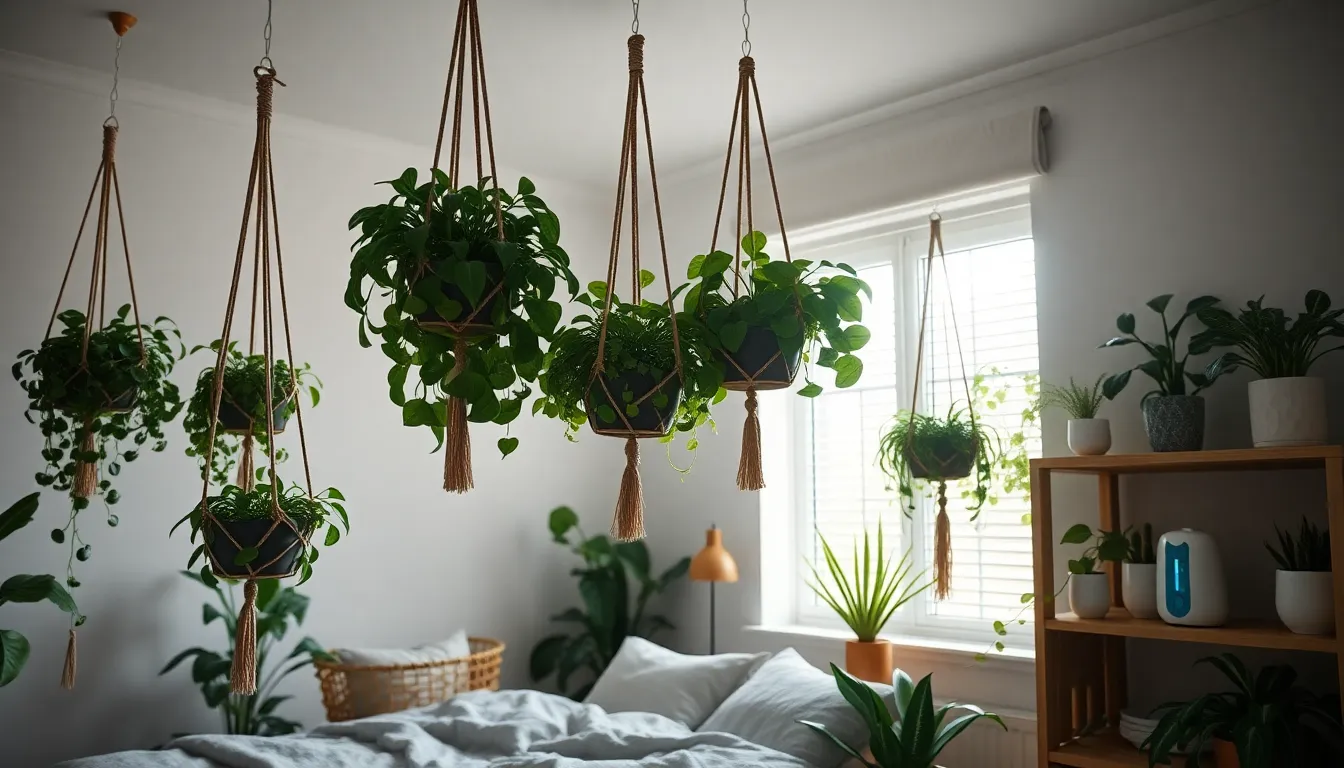
Creating the perfect environment for our bedroom hanging plants requires attention to three critical factors that directly impact their health and growth. We’ve found that proper humidity, watering techniques, and temperature control make the difference between thriving plants and struggling specimens.
Humidity Levels That Promote Healthy Growth
Indoor hanging plants thrive in moderate to high humidity levels that mimic their natural tropical environments. Bedrooms often struggle with lower humidity, especially when air conditioning or heating systems run continuously.
Group plants together to create a micro-humid environment that benefits all specimens simultaneously. This natural clustering technique allows plants to share moisture through transpiration.
Use a room humidifier to maintain consistent moisture levels throughout the space. Digital humidifiers offer precise control and can maintain the 40-60% humidity range most hanging plants prefer.
Mist plants regularly with distilled water to provide immediate moisture relief. Focus on leaves and surrounding air rather than soaking the soil directly.
Position hanging plants near bathrooms or kitchens when bedroom layouts allow, as these areas naturally maintain higher humidity from daily activities.
Watering Techniques for Overhead Plants
Hanging plants dry out faster than traditional potted plants because they’re more exposed to air circulation from all angles. Their elevated position and typically smaller soil volume require more frequent attention to moisture levels.
Water until excess drains from the pot’s bottom to ensure complete soil hydration throughout the root zone. This thorough approach prevents dry pockets that can stress plant roots.
Allow soil to dry partially between watering sessions, particularly for drought-tolerant varieties like pothos and snake plants. Check soil moisture by inserting your finger 1-2 inches deep.
Use a long-spouted watering can to reach elevated plants without creating spills or awkward stretching. Alternatively, carefully remove plants from hangers for ground-level watering.
Monitor soil moisture frequently since hanging pots often contain less soil volume than floor plants. Weekly checks prevent both overwatering and drought stress.
Temperature Control for Year-Round Success
Indoor hanging plants perform best in stable room temperatures between 65°F and 75°F (18°C to 24°C). Consistent temperatures promote steady growth while preventing the stress-related leaf drop that occurs with frequent fluctuations.
Avoid placement near cold drafty windows where temperature swings can shock sensitive plants. Winter drafts particularly affect hanging plants since they’re more exposed to air currents.
Keep plants away from heating vents that create hot, dry conditions unsuitable for most tropical varieties. Direct heat exposure causes rapid moisture loss and leaf scorching.
Maintain consistent overnight temperatures by avoiding rooms with extreme temperature drops. Bedrooms with good insulation provide the stability hanging plants need for healthy development.
Use thermal curtains or blinds to buffer temperature extremes near windows while still allowing adequate light penetration for photosynthesis.
Design Stunning Plant Arrangements That Enhance Sleep Quality
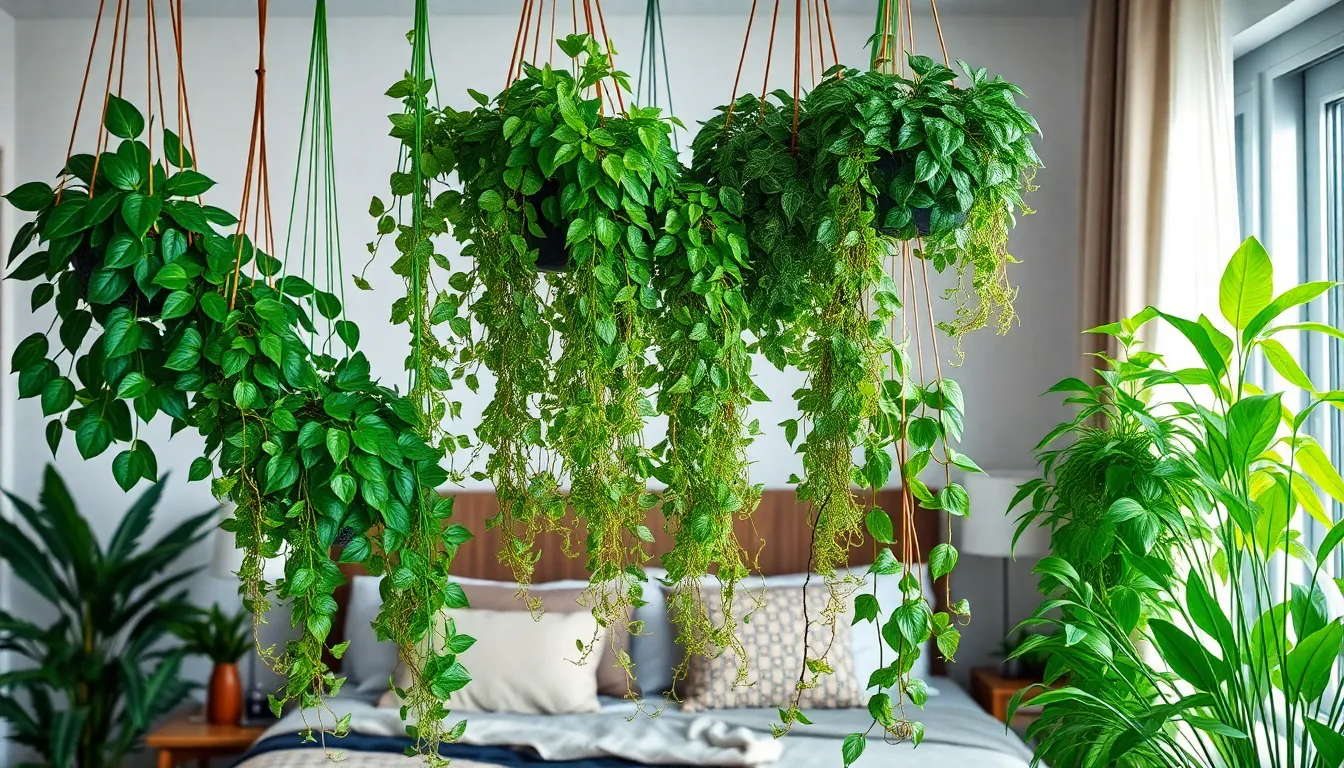
Creating a thoughtful arrangement of hanging plants transforms your bedroom into a peaceful sanctuary that actively promotes better sleep. Strategic placement of plants at eye level adds visual interest while establishing a biophilic connection with nature that reduces stress and enhances relaxation.
Air-Purifying Plants That Improve Bedroom Air
Plants naturally filter toxins from the air around us, contributing to a healthier sleep environment even though they don’t replace mechanical air filtration systems. Hanging varieties like aloe vera work continuously to refresh the air circulating through your bedroom while offering additional benefits for minor skin irritations. We recommend positioning these air-purifying plants near your bed’s head area where you’ll breathe their filtered air most directly throughout the night.
Philodendrons and pothos varieties excel at removing common indoor pollutants while thriving in bedroom conditions. These plants process airborne chemicals through their leaves and root systems, creating cleaner air for deeper, more restorative sleep. Spider plants and snake plants also contribute significantly to air purification when suspended at varying heights around your sleeping space.
Cascading Plants That Create Natural Privacy
Trailing plants like Burro’s Tail (Sedum morganianum) and Chain of Hearts (Ceropegia woodii) form natural visual barriers without requiring bulky furniture or screens. These cascading beauties soften harsh lines in your bedroom while creating intimate, enclosed spaces that feel more secure and comfortable. We’ve found that positioning these plants at different heights creates layers of privacy that feel organic rather than constructed.
String of Pearls and trailing ivy varieties add graceful movement to your bedroom walls while providing gentle separation between different areas of the room. These plants respond beautifully to air circulation, creating subtle motion that’s both calming and visually captivating. Consider hanging them near windows where natural breezes can enhance their cascading effect while maintaining optimal growing conditions.
Multiple Plant Heights for Visual Depth
Incorporating plants at floor, tabletop, and hanging levels creates the rich spatial complexity found in natural environments. This layered approach makes your bedroom feel more ever-changing and inviting while maximizing your use of vertical space. We suggest combining shorter plants on nightstands with medium-height floor plants and hanging varieties at eye level for the most impactful arrangement.
Hanging plants particularly excel at drawing attention upward, brightening dull wall spaces and diverting focus from less attractive room features. Position trailing plants at different heights to create a waterfall effect that guides the eye through your space naturally. This vertical gardening approach transforms empty ceiling areas into green focal points that enhance your room’s overall ambiance and promote the stress-reducing benefits of nature connection.
Maintain Your Hanging Plants Indoor Bedroom Garden
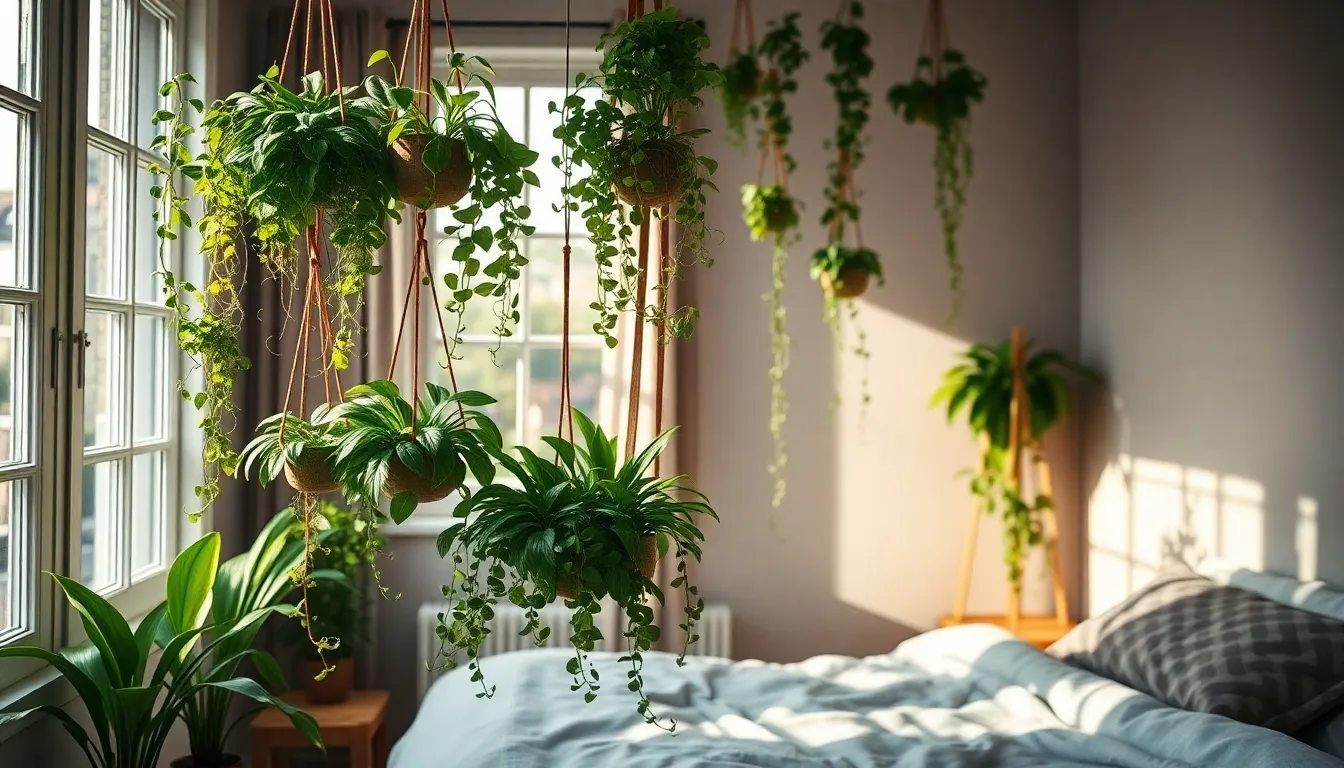
Keeping our bedroom hanging garden thriving requires consistent care and attention to detail. Proper maintenance ensures our plants remain healthy, beautiful, and continue improving our sleep environment.
Regular Pruning and Trimming Schedules
Pruning helps encourage fuller, bushier growth while preventing our hanging plants from becoming leggy or overgrown. We should trim dead or yellowing leaves immediately to maintain plant health and visual appeal. Cutting back long stems keeps our plants in neat, manageable shapes that complement our bedroom decor.
Checking our plants every few weeks during growing season allows us to catch issues early and maintain optimal growth patterns. We’ll want to focus on removing any damaged foliage that could harbor disease or pests. Regular trimming also prevents our trailing plants from growing too long and overwhelming our space.
Fertilizing Requirements for Container Plants
Balanced fertilization during active growing periods keeps our hanging plants vibrant and healthy throughout spring and summer months. We should use water-soluble fertilizer every 4-6 weeks to provide essential nutrients our container plants need. Container soil depletes nutrients faster than outdoor soil, making regular feeding crucial for sustained growth.
Avoiding over-fertilization protects our plants from root damage and foliage burn that can occur with excessive nutrients. We’ll achieve better results with consistent, moderate feeding rather than heavy applications. Proper fertilization maintains the vibrant foliage that makes our bedroom hanging garden so visually appealing.
Common Pest Prevention in Indoor Environments
Regular plant inspection helps us catch pest problems before spider mites, aphids, or mealybugs establish serious infestations. We should examine our hanging plants weekly, checking both sides of leaves for early warning signs. Indoor environments can harbor pests that spread quickly between closely grouped plants.
Maintaining proper humidity and airflow naturally deters many common indoor plant pests while promoting healthy growth. We can wipe leaves with damp cloths or mild soapy water to remove pests and prevent future problems. When infestations do occur, insecticidal soap or neem oil sprays provide effective, bedroom-safe treatment options that won’t compromise our indoor air quality.
Conclusion
We’ve shown you how hanging plants can transform your bedroom into a peaceful green retreat while maximizing your space. With the right low-light plants proper installation techniques and strategic placement you’ll create a stunning vertical garden that improves air quality and enhances your sleep environment.
Remember that success comes from choosing plants suited to your exact conditions and maintaining consistent care routines. Whether you opt for trailing pothos cascading from macrame hangers or sleek ceramic planters filled with snake plants your bedroom will become a healthier more beautiful sanctuary.
Start small with one or two plants and gradually build your hanging garden as you gain confidence. Your bedroom deserves this natural upgrade that brings both style and wellness to your most personal space.
Frequently Asked Questions
What are the main benefits of hanging plants in bedrooms?
Hanging plants offer several key benefits including saving valuable floor space, improving indoor air quality, and enhancing the room’s aesthetic appeal. They can fill awkward corners and create vertical interest while adding a natural, calming element to your sleeping space. These plants also help create a more serene environment that promotes better rest.
Which plants are best for low-light bedroom environments?
The best low-light bedroom plants include Pothos (perfect for beginners), Marble Queen Pothos with striking variegated leaves, compact Snake Plant varieties like ‘Hahnii’, and ZZ plants known for drought tolerance. These plants thrive in minimal light conditions and require less maintenance, making them ideal for bedroom settings.
What types of hanging planters work best for bedroom decor?
Popular hanging planter options include macrame hangers for bohemian style, ceramic and pottery planters for modern aesthetics, and lightweight plastic options for high ceilings. Choose planters that complement your bedroom’s design theme while considering the weight capacity and visual impact you want to achieve.
Where should I place hanging plants in my bedroom for optimal growth?
Position hanging plants near windows for natural light while avoiding direct sunlight that can damage leaves. Corner spaces maximize floor area without crowding, and above nightstands provides easy access for care. Monitor plant condition regularly and ensure adequate air circulation around each plant.
How do I properly install hanging plants safely?
Use appropriate ceiling hooks or wall-mounted brackets based on plant weight. Lightweight plants offer installation flexibility, while heavier plants require secure mounting into ceiling joists. Always check weight limits and use proper hardware to ensure safety and prevent damage to your ceiling or walls.
What growing conditions do hanging plants need indoors?
Hanging plants require moderate to high humidity (group plants together or use a humidifier), consistent watering (they dry faster than floor plants), and stable temperatures between 65°F-75°F. Avoid placing plants near drafts or heating vents, and maintain proper air circulation for healthy growth.
How can hanging plants improve sleep quality?
Air-purifying plants like aloe vera, philodendrons, and pothos improve bedroom air quality, promoting better sleep. Strategic placement at eye level creates a peaceful sanctuary, while cascading plants provide natural privacy. The calming presence of greenery helps reduce stress and creates a more restful environment.
What maintenance do hanging plants require?
Regular maintenance includes pruning and trimming to encourage healthy growth, balanced fertilization during growing season, and pest prevention through regular inspections. Monitor humidity levels, water thoroughly when soil feels dry, and rotate plants occasionally for even growth. Remove dead leaves promptly to maintain plant health.

